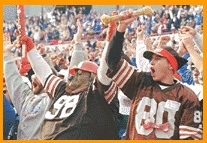|
|
|
The "Dawg Pound"

The bleacher section at Cleveland Municipal Stadium wasn't anything special. It was merely a bunch of wooden planks attached to the concrete structure with steel posts. That is, until game day. On Sunday home dates, fans piled into these very bleachers, and made them into an institution of fans unmatched by any other professional sports team.
The thing that was most special about the Dawg Pound, was the fact that it wasn't a front office ploy. The 'Pound was started by the fans. Hanford Dixon, a popular defensive back for Cleveland in the mid '80's, started 'barking' like a dog to pump up his defensive teammates. Cleveland fans took off with this, and the fans in the bleachers began dressing up like dogs, and mimmicked Dixon's actions. Before too long, the entire 10,000 seat bleacher section was known as the "Dawg Pound." Their unnoficial leader, "Big Dawg" was also their mascot. He, like most other Dawgs, was a blue collar man in a blue collar town.
The Dawg pound grew and grew. Along the way, they began to get national recognition, and got a reputation as being a bunch of unruly fans sitting in the cheap seats. This was a reputation that they relished, and as the seasons went on, they did everything they could to uphold and expand it. Many Browns players stated that this group was no less than a 12th man on the field. The Pound proved this on more than one occasion, but perhaps the most remembered example of this was a game against the hated Denver Broncos.
Denver came to Cleveland, on the heels of beating them in the AFC Championship game the year before. The two teams did battle, and early in the fourth quarter, John Elway found his offense pinned against the goal line, on the Dawg Pound side of the field. The crowd noise was so loud, that Elway's line couldn't hear the calls from their QB. That's not where the harrasment ended, though. Fans from the vaunted Dawg Pound began pelting the Broncos with everything from Milkbones to batteries. This continued for about 10 minutes, and even warnings to the fans from the referee couldn't stop this attack. As it turned out, the game officials had to move Denver to the other side of the field to finally end this "Air War." This move, one not performed in the NFL for as long as anyone could remember, was extremely significant because it put the Broncos in a position where they were driving against the wind. This turned out to be a huge factor as Cleveland forced a Denver punt into the wind, and set up excellent field position. Cleveland used this field position to win the game.
 |
Big Dawg and his crew didn't have a happy ending, though. After team owner Art Modell announced the move to Baltimore in 1995, the infamous "Trail of Tears" began, as Cleveland fans knew there would only be 3 more home games left, possibly ever. As the final gun sounded in the last of those games, a 26-10 victory over the Bengals, Browns' players went to the stands and thanked the fans for all they did. Many players went over to the Pound, and some stayed for over an hour amid the sounds of seats and railings being ripped from their place in the Stadium, taken as souvineers. What seemed like the end really was not, though. Big Dawg began to lead the fans' fight to keep the team in Cleveland. He even testified to the House Judiciary Committee on the issue. He, and all of the Cleveland fans, were rewarded with a new team, stadium, and dawg pound.
|
This version of the 'Pound, though, may never be the same. The new Cleveland Browns Stadium labeles it's bleacher section "The Dawg Pound," a label affixed by the leadership of the team, not the fans. This makes it loose some of it's mystique, some of it's heratige, and some of it's meaning. Only time and games won will tell if this new "Dawg Pound" will bring back the fellowship of the fans, the love of the team by the fans, and the same feelings fans everywhere had in the AFC Championship days.
|